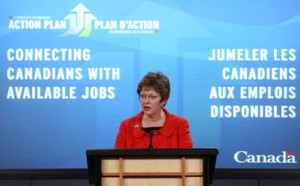The Harper government is planning to change the federal Employment Insurance program to encourage the long-time unemployed to take available Canadian jobs, which could reduce the demand for foreign workers in Canada’s resource and service industries.

Human Resources Minister Diane Finley announced changes to the EI program on Thursday (Human Resources and Skill Development Canada)
Canadian Immigration Minister Jason Kenney had earlier noted the anomaly of regions of Canada with high unemployment rates being forced to bring in foreigners to fill vacant jobs primarily in the resource sector due to too few Canadians being willing to do them.
The new EI rules could remedy this situation by increasing the incentive for unemployed Canadians to take up resource-sector and menial labour jobs. Minister of Human Resources, Diane Finley, in an announcement introducing the proposed changes, said the purpose of the new rules was to “connect Canadians with available jobs in their local area”.
The changes could also mean that foreign workers could see a drop in demand from Canadian firms for their labour and be less likely to be granted a Canadian work permit.
New Rules Explained
Under the new changes, EI recipients will be divided into three tiers:
- Long-tenured workers – Canadians who have paid into EI for seven of the preceding ten years and over the preceding five years have collected EI for 35 weeks or less
- Frequent claimants – Canadians who have had three or more claims and received benefits for more than 60 weeks in the preceding five years
- Occasional claimants – All other claimants
Long-tenured workers will receive benefits for 18 weeks without having to expand their job search to different occupations. In this period, they will lose their EI benefits if any job that pays at least 90 percent of their previous earnings and is the same occupation as their previous job is available to them and they refuse to take it.
After 18 weeks, they would lose their benefits if there is any job that pays at least 80 percent of their previous earnings and is in a similar industry as their previous job is available to them and they refuse to take it.
Occasional claimants will receive benefits for six weeks without having to expand their job search to different occupations. In this period, they will lose their benefits if any job that pays at least 90 percent of their previous earnings and is the same occupation as their previous job is available tot hem and they refuse to take it.
After six weeks, they would lose their benefits if there is any job that pays at least 80 percent of their previous earnings and is in a similar industry as their previous job is available to them and they refuse to take it. After 18 weeks, they would lose they would lose their benefits if there is any job in any industry that pays at least 70 percent of their previous earnings available to them and they refuse to take it.
Frequent claimants will receive benefits for six weeks without having to expand their job search to different industries. In this period, they will lose their EI benefits if any job that pays at least 80 percent of their previous earnings and is in a similar industry as their previous job is available to them and they refuse to take it.
After six weeks, they would lose their benefits if there is any job in any industry that pays at least 70 percent of their previous earnings available to them and they refuse to take it.
The new rules also require claimants to travel up to an hour to work an eligible job.
Uncertain Economic Impact
It remains to be seen how effective the coming changes will be in reforming EI to encourage Canadians on it to find jobs.
Amela Karabegovic, an economist for the Fraser Institute, believes that the changes are relatively minor tinkering and don’t fix the fundamental flaws of the current Employment Insurance model.
In an interview with CICS, Ms. Karabegovic said that the major problem with federal Employment Insurance is that the premiums employers and employees pay are a fixed percentage of income, that isn’t adjusted for risk, making it unlike any other type of insurance.
“The incentives are such that some individuals may over-use it. To give you an example, imagine having car insurance where no matter of how many claims you make, you pay the same premium. Regardless how many accidents you get in, regardless of your age, and so on.
Similarly with Employment Insurance, unless the premiums are adjusted to reflect risk, obviously some individuals are going to over-use it,” Ms. Karabegovic said.
“Instead of making marginal changes, there has to be a more fundamental change in order for the system to work properly, to do what it’s supposed to do which is to provide temporary assistance to those who unexpectedly lost their jobs”.











